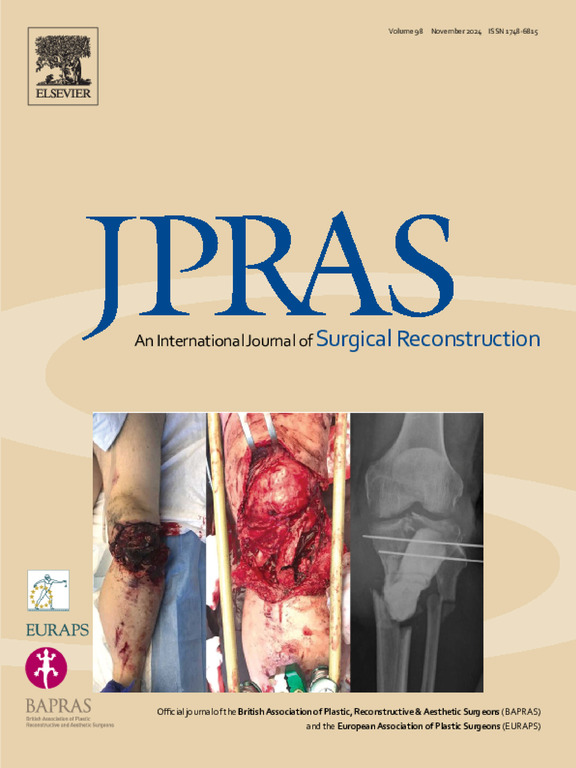三角瓣结合全厚皮肤移植修复圆锥型小耳症。
IF 2
3区 医学
Q2 SURGERY
Journal of Plastic Reconstructive and Aesthetic Surgery
Pub Date : 2025-01-01
DOI:10.1016/j.bjps.2024.11.032
引用次数: 0
摘要
背景:小耳畸形是一种常见的先天性颅面畸形,由于耳廓组织残留较大,手术方法灵活,耳廓型小耳畸形具有独特的挑战性。采用三角形皮瓣联合全层植皮技术治疗耳甲型小耳蜗,效果显著。方法:于2023年1月至2024年6月对35例单侧甲壳型小耳聋患者进行研究。所有患者均采用三角皮瓣联合全层植皮法重建。精确测量耳廓术前和术后数据并进行统计分析,监测患者满意度及术后并发症。结果:35例患者随访3 ~ 13个月。术前患耳平均长度、宽度和周长分别为4.79±0.28 cm、2.44±0.24 cm和9.10±0.54 cm。术后即刻患耳的平均长度、宽度和周长分别为5.35±0.30、2.85±0.25和10.16±0.54 cm。结论:三角形皮瓣联合全层植皮是治疗耳甲型小耳廓的有效方法,能最大限度地利用残余耳廓,简化治疗程序,修复效果满意。本文章由计算机程序翻译,如有差异,请以英文原文为准。
Triangular flaps combined with full-thickness skin graft for repairing concha-type microtia
Background
Microtia is a common congenital craniofacial malformation, with concha-type microtia presenting unique challenges due to the relatively large residual auricle tissue and flexible surgical methods. The authors employed triangular flaps combined with full-thickness skin graft technique for treating concha-type microtia, achieving marked treatment effects.
Method
Thirty-five patients with unilateral concha-type microtia were enrolled in this study from January 2023 to June 2024. All patients underwent reconstruction using the triangular flaps combined with full-thickness skin graft method. Pre-and postoperative data regarding the auricles were precisely measured and statistically analyzed, and patient satisfaction along with postsurgery complications were monitored.
Results
Overall, 35 patients were followed-up for 3 to 13 months. The mean preoperative length, width, and perimeter of the affected auricle were 4.79 ± 0.28, 2.44 ± 0.24, and 9.10 ± 0.54 cm. The mean immediate postoperative length, width, and perimeter of the affected auricle were 5.35 ± 0.30, 2.85 ± 0.25, and 10.16 ± 0.54 cm. Significant differences were observed when comparing immediate postoperative and last follow-up results to preoperative measurement (P < 0.05). No significant difference was observed in the dimensions of the postoperative auricle compared to that of the unaffected side. All patients expressed satisfaction with the treatment effect and no complications were reported.
Conclusion
The method using triangular skin flaps combined with full-thickness skin graft proved to be a remarkable approach for concha-type microtia, maximizing the utilization of the residual auricle, simplifying the treatment procedures, and yielding satisfactory repair outcomes.
求助全文
通过发布文献求助,成功后即可免费获取论文全文。
去求助
来源期刊
CiteScore
3.10
自引率
11.10%
发文量
578
审稿时长
3.5 months
期刊介绍:
JPRAS An International Journal of Surgical Reconstruction is one of the world''s leading international journals, covering all the reconstructive and aesthetic aspects of plastic surgery.
The journal presents the latest surgical procedures with audit and outcome studies of new and established techniques in plastic surgery including: cleft lip and palate and other heads and neck surgery, hand surgery, lower limb trauma, burns, skin cancer, breast surgery and aesthetic surgery.

 求助内容:
求助内容: 应助结果提醒方式:
应助结果提醒方式:


